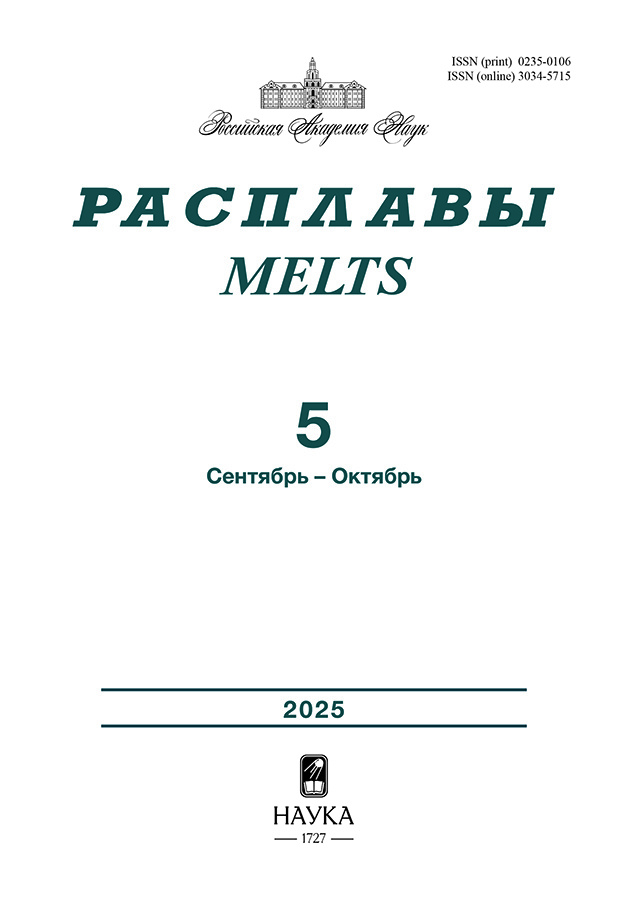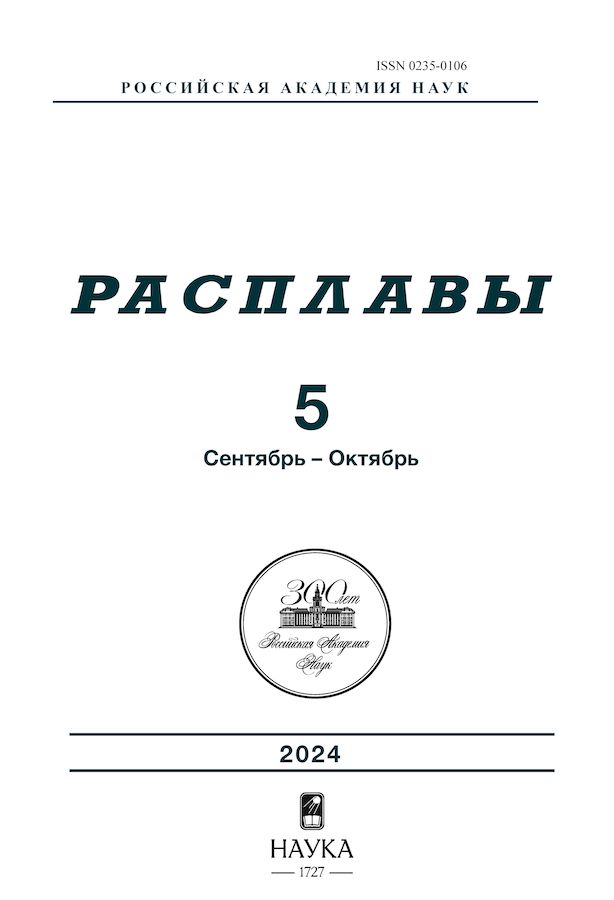Оценка энтальпии смешения расплавов системы Sn-Ag-Cu при 1423 К по данным о свойствах бинарных подсистем с использованием геометрических моделей растворов
- Авторы: Быков А.С.1, Олейник К.И.1
-
Учреждения:
- Институт металлургии УрО РАН
- Выпуск: № 5 (2024)
- Страницы: 565-574
- Раздел: Статьи
- URL: https://rjraap.com/0235-0106/article/view/662061
- DOI: https://doi.org/10.31857/S0235010624050101
- ID: 662061
Цитировать
Полный текст
Аннотация
В статье рассматривается оценка энтальпии смешения ΔНmix расплавов тройной системы Sn-Ag-Cu при температуре 1423 К по полученным нами ранее калориметрическим данным о тепловых эффектах смешения бинарных подсистем Ag-Cu, Ag-Sn и Cu-Sn. Для выполнения оценки ΔНmix были привлечены геометрические модели Toop’а, Kohler’а и Muggianu, в каждой из которых бинарные данные совместно обрабатываются по определенной математической процедуре. Результаты расчетов по указанным моделям представлены концентрационными зависимостями ΔНmix тройной системы в форме 3D поверхностей, проекций этих поверхностей на плоскость концентрационного треугольника, а также изотерм, построенных для отдельных квазибинарных сечений. Обнаружено, что моделирование по Kohler’у и Muggianu дает незначительно различающиеся результаты, тогда как в модели Toop’а величины теплоты смешения тройных составов заметно сдвинуты в отрицательную (экзотермическую) область. Из научной литературы известно, что правильный выбор геометрической модели зависит от принадлежности изучаемой тройной системы к «симметричному» или «асимметричному» типу. Форма имеющихся изотерм ΔНmix бинарных подсистем указывает на то, что система Sn-Ag-Cu является «асимметричной». Результаты, полученные с помощью модели Toop’а, признаны наиболее корректными, как как именно эта модель рекомендуется в литературе для описания «асимметричных» систем. Отмечены общая ограниченность всех геометрических моделей, учитывающих только двойные межчастичные взаимодействия, и целесообразность дополнительных экспериментальных исследований образования трехкомпонентных расплавов для выявления возможного вклада тройных взаимодействий в энтальпию смешения.
Об авторах
А. С. Быков
Институт металлургии УрО РАН
Автор, ответственный за переписку.
Email: 1007o1007@gmail.com
Россия, Екатеринбург
К. И. Олейник
Институт металлургии УрО РАН
Email: 1007o1007@gmail.com
Россия, Екатеринбург
Список литературы
- Рогачев А.С. Структура, стабильность и свойства высокоэнтропийных сплавов // Физика металлов и металловедение. 2020. 121. № 8. С. 807–841.
- Decterov S.A. Thermodynamic database for multicomponent oxide systems // Chim. Techno Acta. 2018. 5. P. 16–48.
- Toop G.W. Predicting ternary activities using binary data // Trans. Metall. Soc. AIME. 1965. 233. P. 850–855.
- Kohler F. Zur berechnung der thermodynamischen daten eines ternären systems aus den zugehörigen binären systemin // Monatsh. Chem. Verw. Anderer Wiss. 1960. 91. P. 738–740.
- Muggianu Y.M., Gambino M., Bros J. Enthalpies de formation des alliages liquides bismuth-étain-gallium à 723 K. Choix d’une représentation analytique des grandeurs d’excès intégrales et partielles de mélange // J. Chim. Phys. Phys.-Chim. Biol. 1975. 72. P. 83–88.
- Олейник К.И., Быков А.С. Калориметрическое исследование образования жидких сплавов Ag–Cu–Sn. Энтальпия смешения в граничных бинарных системах Cu–Ag, Cu–Sn и Ag–Sn при 1150°C // Расплавы. 2019. № 5. С. 12–17.
- Oleinik K.I., Bykov A.S. Calorimetric study of the formation of liquid Ag–Cu–Sn alloys. Enthalpy of mixing for the boundary binary Cu–Ag, Cu–Sn, and Ag–Sn systems at 1150° C // Russian Metallurgy (Metally). 2019. 2019. P. 131–134.
- Sharkey R.L., Pool M.J., Hoch M. Thermodynamic modeling of binary and ternary metallic solutions // Metall. Trans. 1971. 2. P. 3039–3046.
- Pool M.J., Predel B., Schultheiss E. Application of the Setaram high temperature calorimeter for the determination of mixing enthalpies of liquid alloys // Thermochim. Acta. 1979. 28. P. 349–358.
- Luef C., Flandorfer H., Ipser H. Lead-free solder materials: experimental enthalpies of mixing in the Ag-Cu-Sn and Cu-Ni-Sn ternary systems // Z. Metallkd. 2004. 95. P. 151–163.
- Nazeri M.F.M., Ismail A.B., Mohamad A.A. Effect of polarizations on Sn-Zn solders alloys in alkaline electrolyte // J. Alloys Compd. 2014. 606. P. 278–287.
- Ho C.-Y., Tsai M.-T., Duh J.-G., Lee J.-W. Bump height confinement governed solder alloy hardening in Cu/SnAg/Ni and Cu/SnAgCu/Ni joint assemblies // J. Alloys Compd. 2014. 600. P. 199–203.
- Huang M., Zhao N, Liu S., He Y. Drop failure modes of Sn–3.0Ag–0.5Cu solder joints in wafer level chip scale package // Trans. Nonferrous Met. Soc. China. 2016. 26. P. 1663–1669.
- Shnawah. D.A., Said S.B.M., Sabri M.F.M., Badruddin I.A., Che F.X. High-reliability low-Ag-content Sn–Ag–Cu solder joints for electronics applications // J. Electron. Mater. 2012. 41. P. 2631–2658.
- Amin N.A.A.M., Shnawah D.A., Said S.M., Sabri M.F.M., Arof H. Effect of Ag content and the minor alloying element Fe on the electrical resistivity of Sn–Ag–Cu solder alloy // J. Alloys Compd. 2014. 599. P. 114–120.
- Elhosiny Ali H., El-Taher A.M., Algarni H. Influence of bismuth addition on the physical and mechanical properties of low silver/lead-free Sn-Ag-Cu solder // Mater. Today Commun. 2024. 39. 109113.
- Zhao X., Zhao M., Cui X., Xu T., Tong M. Effect of cerium on microstructure and mechanical properties of Sn-Ag-Cu system lead-free solder alloys // Trans. Nonferrous Met. Soc. China. 2007. 17. P. 805-810.
- Zhang R.F., Zhang S.H., He Z.J., Jing J., Sheng S.H. Miedema Calculator: A thermodynamic platform for predicting formation enthalpies of alloys within framework of Miedema’s Theory // Comput. Phys. Commun. 2016. 209. P. 58–69.
- Hillert M. Empirical methods of predicting and representing thermodynamic properties of ternary solution phases // Calphad. 1980. 4. P. 1–12.
Дополнительные файлы











